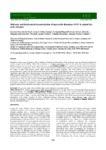Use este identificador para citar ou linkar para este item:
http://www.alice.cnptia.embrapa.br/alice/handle/doc/1037521Registro completo de metadados
| Campo DC | Valor | Idioma |
|---|---|---|
| dc.contributor.author | DEUS, K. E. de | pt_BR |
| dc.contributor.author | LANNA, A. C. | pt_BR |
| dc.contributor.author | ABREU, F. R. M. | pt_BR |
| dc.contributor.author | SILVEIRA, R. D. D. | pt_BR |
| dc.contributor.author | PEREIRA, W. J. | pt_BR |
| dc.contributor.author | BRONDANI, C. | pt_BR |
| dc.contributor.author | VIANELLO, R. P. | pt_BR |
| dc.date.accessioned | 2016-03-30T05:41:35Z | - |
| dc.date.available | 2016-03-30T05:41:35Z | - |
| dc.date.created | 2016-02-18 | pt_BR |
| dc.date.issued | 2015 | pt_BR |
| dc.identifier.citation | Australian Journal of Crop Science, v. 9, n. 8, p. 744-753, 2015. | pt_BR |
| dc.identifier.issn | 1835-2707 | pt_BR |
| dc.identifier.uri | http://www.alice.cnptia.embrapa.br/alice/handle/doc/1037521 | pt_BR |
| dc.description | Drought is a major cause of reduced yield in upland rice farming in many regions of the world and cause an increased production of reactive oxygen species (ROS), followed by activation of a complex antioxidant system. In this study, the superoxide dismutase (SOD) enzymatic activity and the gene expression levels of eight isoforms of SOD were evaluated in drought-tolerant and drought-sensitive varieties of upland rice, Oryza sativa japonica (the Primavera and Douradão cultivars), including shoot and root tissues in two stages of plant development, grown under normal and restricted irrigation. The SOD activity was determined by spectrophotometric method and the gene expression by qPCR experiments. In the tolerant cultivar, SOD enzymatic activity increased significantly (p ≤ 0.05) only in the root tissue in the reproductive stage (268.00 SOD UN mg-1), whereas in the sensitive cultivar, SOD increased in the leaf (112.17 SOD UN mg-1) and root (172.56 SOD UN mg-1) tissues in the reproductive stage. The genes CuZnSOD4 and MnSOD showed significant increases in expression (p ≤ 0.05) in both tissues and developmental stages in the tolerant cultivar under drought, whereas FeSOD1 showed increased expression (p ≤ 0.05) only in the tolerant genotype (vegetative stage/leaf and root) under water restriction. The different patterns of SOD activity and/or gene expression in upland rice plants should be strongly considered to elucidate the cellular mechanisms of drought tolerance; these findings may ultimately inform breeding programs aimed at more efficiently developing cultivars that are better adapted to areas prone to water deficits. | pt_BR |
| dc.language.iso | eng | eng |
| dc.rights | openAccess | eng |
| dc.subject | Enzymatic activity | pt_BR |
| dc.title | Molecular and biochemical characterization of superoxide dismutase (SOD) in upland rice under drought. | pt_BR |
| dc.type | Artigo de periódico | pt_BR |
| dc.date.updated | 2016-03-30T05:41:35Z | pt_BR |
| dc.subject.thesagro | Arroz | pt_BR |
| dc.subject.thesagro | Oryza sativa | pt_BR |
| dc.subject.thesagro | Resistencia a seca | pt_BR |
| dc.subject.nalthesaurus | Rice | pt_BR |
| dc.subject.nalthesaurus | Water stress | pt_BR |
| dc.subject.nalthesaurus | Oxidative stress | pt_BR |
| dc.subject.nalthesaurus | Gene expression | pt_BR |
| dc.subject.nalthesaurus | Superoxide dismutase | pt_BR |
| riaa.ainfo.id | 1037521 | pt_BR |
| riaa.ainfo.lastupdate | 2016-03-29 | pt_BR |
| dc.contributor.institution | KARINNE EVARISTO DE DEUS, UFG; ANNA CRISTINA LANNA, CNPAF; FERNANDA RAQUEL MARTINS ABREU, UFG; RICARDO DIOGENES DIAS SILVEIRA; WENDELL JACINTO PEREIRA, UFG; CLAUDIO BRONDANI, CNPAF; ROSANA PEREIRA VIANELLO, CNPAF. | pt_BR |
| Aparece nas coleções: | Artigo em periódico indexado (CNPAF)  | |
Arquivos associados a este item:
| Arquivo | Descrição | Tamanho | Formato | |
|---|---|---|---|---|
| CNPAF2015ajcs.pdf | 636.28 kB | Adobe PDF |  Visualizar/Abrir |









